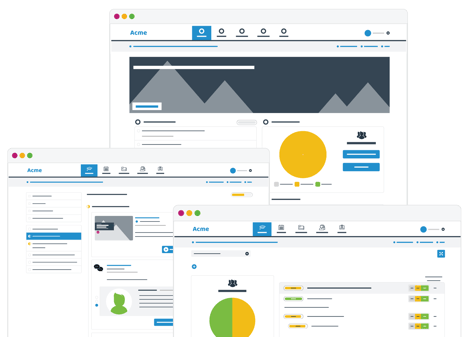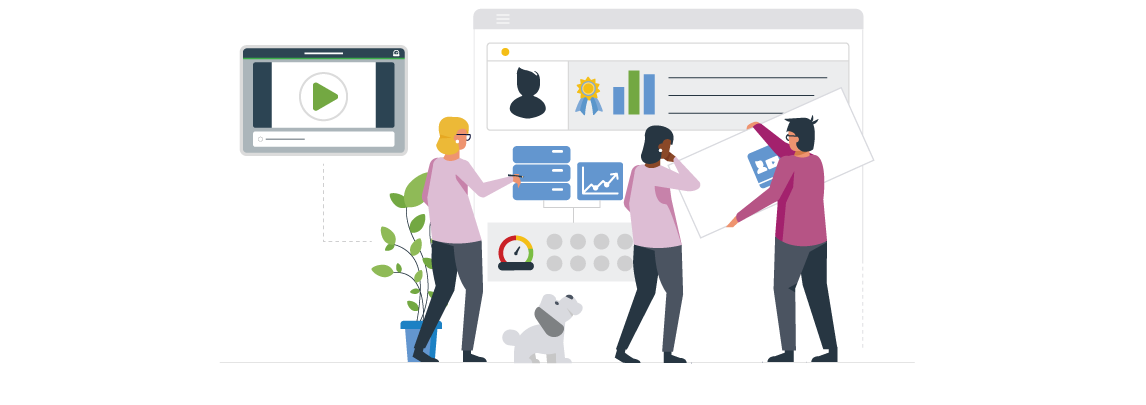With an influx of people working from home and hybrid working over the last two years, the eLearning industry has thrived, developing a wide range of learning platforms for companies to train and upskill their employees. However, with so many learning platforms available, it can be difficult to ensure that you are getting the best training that supports the learning needs of your employees and the organisation.
Many companies face the problem of providing training, such as for onboarding and compliance, that contains content-heavy information, generally forgotten by employees after a month or two. The traditional learning that is implemented across organisations usually lacks vital personalisation and engagement qualities that support knowledge retention. So what is the best way to support employees to upskill and actually retain the knowledge?
One solution is to establish a learning ecosystem.
A learning ecosystem combines technologies, learning material and data that enhance an organisation’s learning processes into a unified and holistic network of systems - each powering a specific learning experience. A learning ecosystem combines multiple learning platforms to cater for compliance, product training, self-directed learning, reskilling/upskilling purposes, transformation etc. By establishing an effective learning ecosystem, you will be equipped with the right mix of systems, resources and processes to deliver your organisation’s learning strategy.
Let’s take a closer look at the different learning systems and platforms that may form a part of your learning ecosystem.
Learning Management Systems (LMS)
An LMS is an essential tool to any organisation and a great way to ensure that all compliance training is completed. Generally, these programs are designed to be efficient, cost-effective sessions that train employees quickly. The data collected from these systems efficiently identifies who has completed the required training and displays the results that will specifically outline areas for improvement.
The downfall of an LMS is that it trains people for the purpose of “not screwing up” rather than exciting the learner to improve on their organisational knowledge or skillset. It is also not created with the purpose of personalising the content to appeal to the learner’s needs or interests. The LMS experience commonly concludes with a short quiz to examine how well the learner retained knowledge from the session. While this is an effective method for the short-term, employees usually struggle to remember their training over a long period of time.
Learning Experience Platforms (LXP)
An LXP can be described as a “self-directed life-long learning platform”. It helps learners to build their skill sets with no due date and enables businesses to discover, develop and measure their organisational broad set of capabilities. Courses hosted on LXPs are specifically curated to the organisation's needs, but self-directed in nature, enabling skill development that can be completed within a timeframe that is suitable for the individual. An LXP delivers all content on a centralised platform that can be supplemented with resources such as articles, podcasts, blogs, micro-learning activities, and videos, to create a rich learning experience for the individual. LXPs have the flexibility of use across multiple devices, making learning accessible for a wide range of learners. Data collected from the learners then allows the platform to recommend additional learning resources to help employees to achieve their goals at a quicker rate. It should be noted that the line between LMS and LXP is becoming increasingly blurred.
Content Subscription Platform
To supplement an LMS or LXP platform in the workplace, companies have started to cater for the interests and needs of employees by purchasing subscriptions to a content subscription platform such as LinkedIn Learning or Udacity. Content subscription platforms are a fantastic way for employees to feel motivated about professional development, having the freedom to choose self-directed learning that caters for their needs and interests. Similar to an LXP, the data collected from these platforms is used to recommend additional courses and motivate the individual to continue learning.
Content subscription platforms are a great tool to supplement employees’ learning interests as a wide range of content can be discovered readily at your fingertips, making it a great addition to LMS. Pairing these self-directed courses with individual performance goals could significantly increase long-term engagement. However, getting full utilisation from such services takes a lot of effort. Content subscription platforms must be promoted heavily within the organisation to ensure people remember to use them and to create the time to use them.
Learning Marketplaces
Learning marketplaces such as; Udemy, Thinkific, and Go1, have a wide variety of learning content that caters for a wide variety of learner interests, similar to a content subscription platform. What separates these platforms, however, is that learning marketplaces source their content from third party suppliers and individual contributors, while content subscription platforms create their courses internally. Learning marketplaces aggregate learning content from multiple online sources, meaning that the variety and quality of education vary from course to course. Similarly to a content subscription platform, these courses require self-direction and drive from the individual to complete the course.
Upskilling Platforms - Guroo Academy
With organisations facing more complex transformational challenges, a new category of learning platforms is needed to service the gap between LMS and LXP. Upskilling platforms focus on delivering longer learning journeys (from weeks to months) that enables learning to more effectively power strategic change. Upskilling platforms mix together a wider range of learning activities, targeted not only learning but also learning transfer. The platform allows the learner to easily bring their own context to any program through elements such as personal goal setting and diagnostics. Learning can also be delivered flexibility through methods such as self-paced learning, virtual and in-person learning, manager based coaching and action learning to suit the training needs and requirements of the organisation. Journeys delivered via an upskilling platform are focused on ensuring that at the end of the experience the learning is not just integrated into the participants' context but they are ready to put the new skill into practice and deliver on the strategic goals of their organisation.

Guroo Academy is an example of such an upskilling platform. Academy was specifically created to fill this gap in the organisational learning ecosystems focused on strategic upskilling. ACADEMY is a flexible platform that can be used for a specific upskilling initiative, such as introducing Agile Ways of Working or creating an organisation-wide upskilling Academy. It can also be used by learning provides to deliver upskilling experiences to their clients. Learning More about Academy here.
So out of all these options, what is the best learning experience for your company?
A mixture of learning systems will effectively support the learning objectives of your organisation, however, it is unlikely to achieve these objectives with just one platform.
Establishing a learning ecosystem is the best way to ensure you have the right mix of tools for your strategic objectives.

.png)

